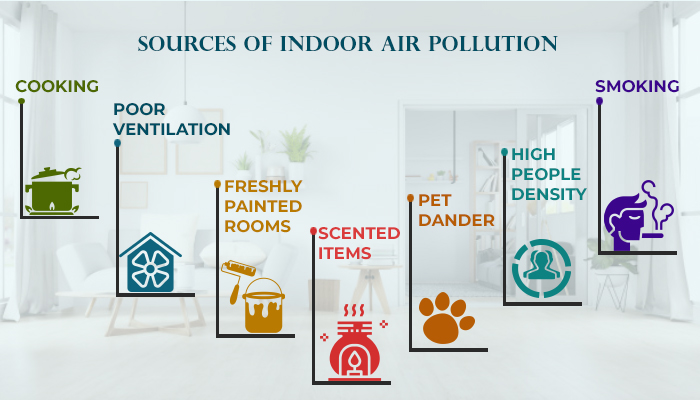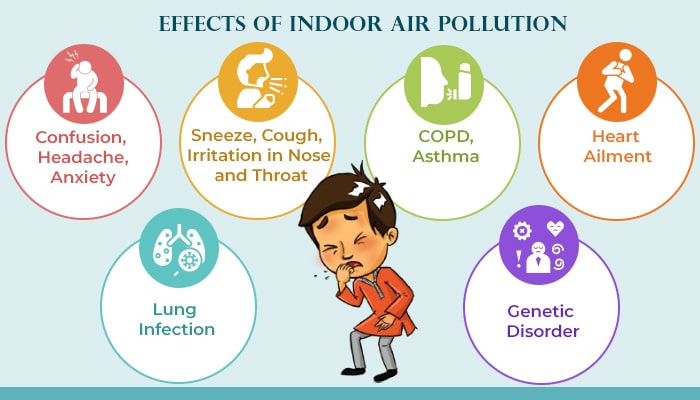The entire world is currently grappling with the COVID-19 pandemic. The global lockdown scenario caused a visible positive impact on outdoor air quality. However, this restriction has put a big question mark on the status of indoor air quality.
Actually, the air quality in your home can be far more toxic and dreadful than what you may experience outside. The levels of a few air pollutants can be 2 to 5 times higher than their typical outdoor levels.
So, here are 13 tips to control your indoor air quality.

Key Pollutants that affect your Indoor Air Quality
1. Ventilation is the Key
Ensuring sufficient ventilation is one of the simplest and most effective ways to ensure that you are breathing ‘good’ air. Keep the windows open to facilitate a natural exchange of indoor and outdoor air. Make sure that you run exhaust fans in your kitchen and bathroom to remove fumes from cooking and steam, respectively.
2. Smoking? A No-No for Indoor Air Quality!
Environmental Tobacco Smoke (ETS) is one of the most crucial and dangerous contributors to indoor air pollution. Cigarette smoking releases a substantial amount of breathable particulate matter into the air. These suspended particles make your indoor air unbreathable and toxic for smokers as well as non-smokers.
So make your place a cigarette-free zone and do not allow anyone to smoke those vicious buds indoors. However, nothing can be better than quitting this habit altogether.
3. Welcome the right way!
A small change, such as using microfibre doormats at your doorstep, can magically improve the indoor air quality. Even better, make your home a shoe-free zone. Ask your relatives and friends to remove their footwear outside the home. The footwear can infiltrate your place with outdoor pollutants.
4. Filters for the rescue
No, I’m not talking about Snapchat or Instagram filters.
Regularly changing the filters of your air conditioner is a simple yet effective solution to improve the indoor air quality. Filters trap the air pollutants onto their surface, and choked filters can be detrimental to the air quality.
If you have central heating, ventilation, and air conditioning (HVAC) system installed at your place, then you should give pre-filters a try to absolve the problem of indoor air pollution.
Using car cabin filters can also prove fruitful to improve the indoor air quality of your car and save it from turning into a gas chamber.
5. Keep it Natural
A simple way to improve your indoor air quality is by avoiding the use of any artificial odor. Air fresheners, deodorants, and scented laundry detergents release airborne pollutants called volatile organic compounds (VOCs) into your indoor air.
These compounds degrade the quality of your indoor air and lead to many health-related disorders, including cancer. This makes natural odor the best choice for a healthy living.
6. Cleanliness is next to Godliness
Keep your place clean to breathe clean air. Brooming can stir more dust and degrade the indoor air quality by keeping the pollutants suspended in the air. Mopping is an economical and more effective method of cleaning than dusting or brooming. Moreover, using microfiber dusting cloth traps more dust than a cotton rag while mopping.

7. Handle chemicals with care
All the household chemicals must be sealed after use. We use a lot of chemicals that vaporize upon exposure to air, such as vinegar, kerosene, petrol, varnish, nail paint remover, etc. Such compounds are called volatile compounds. Their leakage can result in the release of harmful toxins in the indoor air and degrade its quality. Therefore, you should make sure that they are sealed and stored safely after use.
Paints are a source of VOCs. Freshly painted rooms result in the release of these compounds in the indoor air, which can be detrimental to human health. So make sure that you schedule indoor painting when your place is the least occupied. Also, buy the quantity of paint as per requirement and store any leftovers in a closed, dark space.
8. Code Green
The most eye-pleasing, economic, and effective solution to indoor air quality problems is indoor plants. Having indoor plants by your study table, bedside, or a mini-garden on your balcony is one of the most promising solutions. These will eliminate the traces of some dreadful toxins and provide you with fresh and pure oxygen.
Some of the indoor plants that require minimum maintenance and best results are- Peace Lily, Kimberley Queen Fern, Dragon Tree, Red Emerald Philodendron, Spider Plant, Aloe Vera, etc.
9. Pet them right
Believe it or not, but having pets contribute to decreased indoor air quality. Pet dander is one of the sources of indoor air pollution.
However, it can be controlled if you take the right care of the beloved members of your family. Bathe them at regular intervals and wash their bedding to reduce allergy-causing dander.
Also, try to not let them sleep on your bed and vacuum their trail often.
10. Dry it all
High humidity makes you feel uncomfortable, right? Well, it makes the indoor air equally deplorable. High humidity is one of the arch-nemesis of indoor air. It facilitates the growth of mold and mildew in the indoor environment. High humidity also helps bacteria and viruses to flourish, which makes you more susceptible to infections.
So, make sure to keep your household environment dry and disease-free!
11. Cover your trash
What comes to your mind when you hear about uncovered or overflowing waste? Stink, right? But did you know that it is equally toxic for the indoor air quality! Bacteria, insects, pests, and vermin thrive on uncovered waste. They also provide a larger surface area for pollutants to settle.
So, always keep your waste covered.

Effects of indoor air pollution
12. De-clutter your abode
Imagine having to clean a room filled with furniture and electronics! Only imagining such a scenario can bring you to sweat. Not only is a cluttered room harder to clean, but it also provides a larger surface area for pollutants to settle. The accumulated dust, pollen, allergens, and other contaminants can deteriorate the quality of air around you.
Carpets are one of the primary accused. Carpets may trap pollutants like dust mites, pet dander, allergens, particle pollution, lead, mold spores, dirt, and dust. Toxic gases in the air can stick to small particles that settle on the surface of carpets. These pollutants may become airborne during renovations, vacuuming, or even daily activities, like walking over the carpet. They may also get suspended in the air while dusting or cleaning.
So, make sure you de-clutter your place and get rid of carpets.
13. Forget all your fears by installing an Air Purifier
An air purifier is a smart choice to counter your indoor air quality problems. However, its installation alone cannot guarantee toxic-free air. You should complement it by adopting other measures as well to ensure that you breathe right.
To buy the right air purifier for your indoor air quality needs, click here.
This post is also available in:
![]() Global
Global ![]() IND English
IND English ![]() UK English
UK English ![]() US English
US English